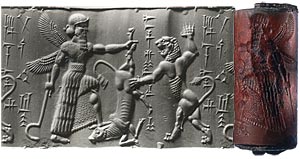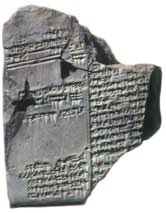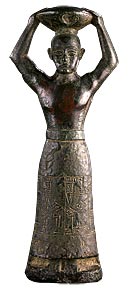The seals collection is one of the most distinguished in the United States and among the best known in the world. These engraved objects provide a continuous artistic and chronological sequence of more than three thousand years. In addition to being great works of art in miniature, they are crucial to our understanding of ancient Mesopotamia.
Morgan's Collection: Beginning and Expansion
Between about 1885 and 1908, the American collector William Hayes Ward assembled, probably on 
Winged hero with scimitar, bull, and lion.
Neo-Babylonian, 701-601 B.C. Morgan Seal 747Pierpont Morgan's behalf, the collection of 1,157 seals that forms the core of the Morgan's collection. Ward summarized Morgan's intentions as follows: "It is the chief object, as I understand it, of Mr. Morgan in bringing to this country the written and figured monuments of the early East, such as tablets, seal cylinders, bas-reliefs or statues, to put within the reach of American scholars the material necessary for adding to the knowledge of the world. ... It is desirable that such objects be not scattered and lost to scholarship, but that they be gathered into responsible and accessible collections."
Although Morgan's collection contained a few important stamp seals, including some later Sassanian examples, most of the seals he acquired were cylinder seals. Two additional major gifts have enhanced the collection: 74 cylinder seals and 70 stamp seals collected by Robert F. Kelley and given by his sister Caroline M. Burns in 1977 and 194 cylinder and 258 stamp seals given by Jonathan P. Rosen in 1986.
Styles and Periods
The seals collection covers all the significant styles of Mesopotamian engraving from the end of the fourth millennium to the fourth century B.C. as well as most of the styles of other countries of the ancient Near East. Areas of particular strength include Babylonian (first dynasty), seals of the second millennium made outside of southern Mesopotamia (Cappadocian, Syrian, and Mitannian), and Neo-Assyrian seals. The Middle Assyrian seals are some of the finest in any collection.
Cuneiform Tablets and Art Objects
Pierpont Morgan collected nearly three thousand cuneiform tablets, the bulk of which
The Deluge Story. Reign of
Ammi-saduqa, king of Babylon,
ca. 1646-1626 B.C. MLC 1889 are now in the Yale Babylonian Collection, which he founded. A few are retained at the Morgan. They include a Neo-Assyrian version of the beginning of the Epic of Adapa, first of the antediluvian sages; the earliest Akkadian version of the familiar Noah motif; a ritual for an eclipse of the moon; letters; a record of sale of a field; and a marriage contract.
The Morgan owns a few outstanding art objects from the ancient Near East. A copper figurine from the time of Gudea, ruler of the city of Lagash (ca. 2144-2124 B.C.) is in the form of a kneeling god holding a peg. A copper foundation figure inscribed with the name of Ur-Nammu (2112-2095 B.C.) represents the first ruler of the Third Dynasty of Ur nude from the waist up, with both arms raised to steady a basket of building materials he carries atop his head. The high quality of the figure indicates that it is the product of a royal workshop. The eye stone amulet of Nebuchadnezzar II, 
Foundation figure of King
Ur-Nammu. Ca. 2112-2095 B.C.king of Babylon (604-562 B.C.), is an agate votive amulet inscribed with a dedication to the god Marduk by the king. A lapis disk with relief carving on both sides is inscribed with the name of Rimush, second king of the Akkade dynasty. Rimush, who reigned from about 2278 to 2270 B.C., doubtless acquired the disk during his military campaign in Iran.
Edith Porada Papers and Seal Impressions
The seals collection was first published in 1948, in the Corpus of Ancient Near Eastern Seals in North American Collections: The Collection of the Pierpont Morgan Library. Dr. Edith Porada, author of the Corpus, was appointed Honorary Curator of Seals and Tablets in 1956, a position she held until her death in 1994. In addition to the Corpus, Porada's legacy to the Morgan includes her library, now part of the Reference Collection, her papers, and her extensive collections of modern seal impressions, photographs, and drawings. These were made from public and private collections around the world, some of which are no longer accessible to American scholars.
CORSAIR, the Morgan's online collection catalog, is available here.
